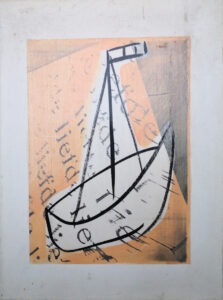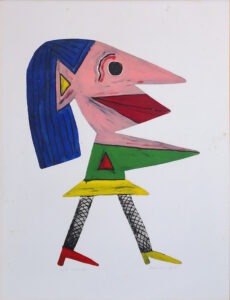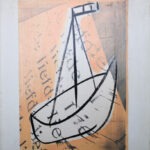COLLECTION ZOOM
Hans Giesen
BIOGRAPHY
Born
1942 Kerkrade, The Netherlands
Residence
The Netherlands
Education
City Academy Maastricht, 1958-1962
Jan van Eyck Academy Maastricht, 1962-1963
Ateliers 63 , Haarlem 1963-1965
University Amsterdam Culture Philosophie, 1970-1972
Paros /Naxos Life – Issue july 2011 – by Vangelis Hatziyannidis.
It almost always seems useful, when weighing my impressions of an art work, to try and remember my reaction — that natural and spontaneous exchange between the mind and the senses — at the very first viewing. While deep and careful consideration, undergone calmly and at leisure, can reveal hidden facets of the work or provide clues to understanding it and its goals, the first viewing uncovers something, I believe, much more fundamental — that is, when it is evoked with accuracy: The intensity with which the work converses with your soul, or, if soul is too vague a concept, your unconscious.
I first saw Hans Giesen’s work in the spring of last year, in Aliki. We had met only a few days before, at the house of our mutual friends, Kosta and Anthi. I remember a very animated discussion taking place about the usefulness (or not) of art in everyday life, and of the existence (or not) of some kind of secret element that renders an art work great. These customary questions regarding art are always capable of provoking excitement among artists sitting around a dinner table. Hans and I later agreed to meet again, and did, for lunch at Manoli’s Taverna in Aliki, he with Jeanne and I with Rania. It was then that I first experienced his work, as he handed me some catalogs from past exhibitions.
Let’s consider the following words side by side: May, Paros, midday, the colors of Hans Giesen. What a shock! The artist’s calm countenance now seemed almost to have deceived me. I was entirely unprepared for war, for there is something war-like about his colors. Even the softer, more congenial colors of Giesen’s palette radiate decisiveness. They are determined to conquer you and will not yield.
It somehow seems that this effect isn’t entirely due to the artist’s skillful manipulation of color, but that the colors themselves are of a different nature, a rare type, to which is added, by some strange process, crushed light. Parian light in powder form, mixed in with the paint.
Then there are the figures. Anarchic, undefined, but with a sweet roundedness, as if they had been poured into a bronze cast. They float, they sail, they whirl; they remain enigmatic — enigmatic but not incomprehensible. This is the work of Hans Giesen. It gives hints and encourages the viewer’s imagination to fill in the blanks.
The catalogs remained on the table even when the food arrived — calamari, green salad, barley rusk topped with fresh, diced tomatoes; colors in conversation. “When we first came to Greece,” Jeanne said, “we weren’t familiar with the rusk. ‘What is this hard, dry bread?’ we said. Of course we later learned to love it.”
This year marks the couple’s twenty-fifth on Paros as permanent residents. How random is a man’s decision about the place in which he’ll drop anchor? Not at all, of course. But what is it that ties us to a certain place, compelling us to call it home? Is it natural beauty? The climate? The people? The air or light? A combination of the above? It’s hard to say. ?t’s hard to decipher the calling.
As it is with determining the essence of art, this question remains unfathomable. There is, however, something certain. People and places are mashed together and both are marked by the process. The colors of the earth, the light of the sky, the clearness of the water, the mysterious aura of Paros, all give Hans Giesen’s work a certain charge, just as Giesen leaves behind his own trace in the place in which he’s chosen to settle, high in the hills of Akgairia. Twenty-five years is a long time, considering the average span of human life.
With the completion of Hans Giesen’s quarter of a century living and working on the island of Paros — and drawing, as he says, from the very first day, strength and inspiration for his painting — we have the pleasure of viewing an exhibition of his work, organized by the Public Cultural Center at the Dimitrakopoulos Building, in concert with the Dutch embassy (Ambassador Mr. van Rij will be presiding at the opening). All the pieces were painted on Paros. It is worthwhile to stand before each one and observe those vital elements that are the mark of art and of Giesen’s craft: the freedom of gesture, the intensity of color, the flight of fancy, qualities which allow us to characterize this artist as truly instinctive.
Tequilla Sunrise/In a different country
Gerrit Komrij/Hans Giesen
Poetry Bundle issued at 10th anniversary poetry publishing Herik
1998
Abomination ( p. 15-16 )
What is the ezeldom a great destiny .
He wants to trade with anyone . In a dream
Appeared to him a while back , a god
Who had introduced him – the sugar daddy ! –
To redeem from his donkey form him.
He could be human again . Man or woman , or both .
He had no braying loudly . Rather a worm .
Rather a grasshopper on the Mokerhei .
A man was someone with too small ears ,
A creature that was only what is visible
Could see and what sound brought forth could hear .
Secret antennas had a donkey only .
J. Bernlef
Off the cuff
Essays on art and music
Querido 1998 edition
Nominated for the Generale Bank Literature 1998
J. fowler
Out of sight / Cartoons
Collection of essays and reflections on art, literature , film and photography .
The 1997 edition Busy Bee
For Hans Giesen
Day after day as layer upon layer
paints is your hand a year
of years , is steadily stacking :
today .
Kusters-1996-Poet
Text of J. Bernlef .
Writer and poet.
From Jaski Art Gallery exhibition catalog , 1992.
In the film ‘ Matter , the influence of light ‘ we see Hans Giesen at work . Quietly he prepares for , squeeze tubes empty , mixes , chooses his brushes . And then , suddenly , he goes on the attack . There is no other word for it. In a few lightning fast sweep he put some marks on the canvas , which polished with a rag through the paint , take away , extends one of the just put down strokes . In the film Giesen says that for him one of the happiest moments of painting such a powerful , confident start. But what exactly happens at that point ? Again and again I looked at the beginning of the film . As if he jumped on the canvas . This was not the eye or the eye and the hand together , after careful consideration, something performed on a canvas, this was a time when the painter ‘s own hand seemed to overplay and , like beaten with blindness , a stab at something unknown did .
What I Giesen had seen in the beginning of the video was an attempt that process speed to be not immediately give to take matters , owned his own stock of inner images the opportunity but they thwart with initially a gesture of paint , that was not a gesture full of meaning , but as the jump of a dancer in space , the greatest possible presence of total body on the canvas of the entire potential of possible paintings . The first parts of the painting do not manifest the conscious intentions of the painter , but also a set of physical action at that particular moment . The first strokes and sweeping have the intention to close the ‘ illustrative process ‘ short and connect with other senses the eye.
Giesen ‘s paintings evoke physical sensations , mixing of the senses , synaesthesias as they say in psychology. His subjects are of primary , physical nature , as if to show than usual . With his paintings a more direct , tangible way of experiencing
In many of Hans Giesens ‘s paintings are the first regions , these manifestations of pure paint , available as a crowbar and pry open the door to a richer experience of the world . The eye of the painter hear what is happening there on the canvas . Between his eyelashes he looks to see if his goal is adequately protected against too facile interpretations , against which ‘ illustrative process ‘ that prevents us to the core of his work to penetrate : a moving place where all senses are reconnected perhaps in a paradisiacal scene .
Review of De Volkskrant
Paul Depondt
October 1992
Giesen is painting as if beaten with blindness . A stab at something unknown .
Review of Kathimerini ,
September 1989 , Athens
A personal expression expressionist whose main subject the observation of human relations and interaction .
Review of Frand Darkness
Kunstbeeld August 7, 1993
A painting by Hans Giesen lives very quickly and at the same time very slowly . The painting stands alone. There is something that is captured and escape escapes on closer inspection many initially had himself collected .
So I already could summarize what is the meaning of Giesens painting, in short one must give some attempts to approach . The clashes in his paintings are not just confrontations between different designs , shapes and situations , they are also meetings between impossible things , which place, time and action are intertwined , as if they withdraw from the laws of classical drama .
On his Amsterdam exhibition (1992 ), he chose as a poem introduction of Octavia Paz in his cryptic form exactly touches what matters in his painting :
“Between what I see and what I say ,
Between what I say and what I love for me ,
Between what I like for me and what I dream ,
Between what I dream and what I forget ,
Poetry . “
A circle poem in which space is created for what is not immediately catch , or better , than can not be captured by feints . Hans Giesen paints in movements that seem to have known , but that once put down in paint demand continues to move toward the unknown .
Text of Doris Wintgens Hötte .
Art critic and curator of museum ‘ The Cloth ‘ in Leiden .
From catalog ‘ Encounters ‘ .
Exhibition Landesmusem Oldenburg , 1988 .
The rather violent brushwork of Giesen ……. do soon suspect that we are dealing with a true expressionist . This is in my opinion is not the case . At least not with a representative of expressionism as a historical movement has grown . In the twentieth century Rather, I would like to place the “fathers ” of the historic expressionism him in the tradition because then continue thinking come across names like William Blake , Edvard Munch , Carlos Saura and Francis about this expressionist tradition in the tradition of Goya and El Greco . And bacon forward .
The ” expressionism ” by Hans Giesen is consider more , distant from nature than what is commonly understood in the 20th century under this term . He is interested in a basic sense that in different ways expression can be given . Not for nothing is he fascinated by the theater of Pina Bausch also where there is a basic idea whose effects can still differ .
Although at the paintings of Hans Giesen hardly a landscape occurs , the nature of the utmost importance for him . Especially the fierce Greek landscape .
Since 1966 Giesen annually spends several months in Greece . Here he feels his primitive wanderings through this inhospitable nature thrown back on the most basic things of human existence .
It is this experience , this contact with basic feelings , he wants to show . Poetically The poetry belongs to Giesen to the essence of his work, it is a sine qua non .
Review of The Limburg Dagblad
Pieter Defesche
June 1996
So it is not surprising as the world of Giesen now less than originally determined by the complex social picture of the suburban metropolis and more by simple olive growers on an island as far away – with his little dramas in houses between mountains and beaches ‘ yellow stone ‘, as one on the invitation card is shown again as a play, this time for rural theater.
It has produced masterful paintings as ‘ Memories of forgotten land IV ‘ which is a miracle of composition and with an atmosphere that may be conjured by a kind of fairy in a cloud of dots .
a marvel of composition
masterly .
” Leaning eyes “
In paintings of Hans Giesen .
Text Jacq Firmin Vogelaar .
Writer and art critic .
From catalog ‘ Encounters ‘ .
Exhibition Landesmusem Oldenburg , 1988 .
It is striking how often faces , and even face , but one eye, and still crooked. Where’s the other ? As if the face while looking at himself , so the eye is out of the picture .
Not only are the eyes in Giesens paintings themselves skewed , usually they look a slanted way . So in the painting Reflections on the edge of the night , a triptych also by its unusual breaks tightened Giesen fractures in his paintings – which left a red headless man is perky to see his nakedness shows and right the seated figure not only her head averts her gaze but is also obliquely pointing towards the ground. She looks away – and the viewer sees what they do not want to see . Also in the conversation in the night are husband and wife separated in 1987 by a white surface, the red man looks , the blue woman turns away from him .
The naked men , almost always bright red , give the impression that they are deprived of their skin , as if they were stripped of bark, stripped of their exterior , they are like a wound . Is there pain to be expected as the man stripped off his uniform and he wants to show the looks of women in the anonymity of flesh, blood and pain ? The women seem , even if they are subjected to moments , obviously enjoying . Their naked forms The red of the skinless man goes into the blue of the night of her imaginary heaven robbed . The upper body of the red naked man , and from shame, shrunken , the blue woman fires her head expanding into grotesque shapes. “The truth is naked ,” wrote Valery , ” but under the nude is the skinless body . Giesen shows the man in his undisguised vulnerability , a ruthlessness that pays off by what comes free. Intriguingly, this does not happen by the look or under the eyes of the woman , but in her blind spot . He wants to be seen , she has apparently sufficient unto itself .
Essentially , the motion , finding and creating space as in the paintings is essential that spaces arise that give great freedom to the viewer , there is always a point beyond which the viewer to make connections through the painting down is left , because the painting is much too much significance . For an artist is way more important than reaching an endpoint , such as search is more important than finding .
Better I can not put into words what happens in the transition state , which Giesens paintings are snapshots , at least for those who want to watch . In Giesens paintings are made possible new forms of looking through old fossilized forms of manifestation. Dancing The painter shows that watching is dancing .





